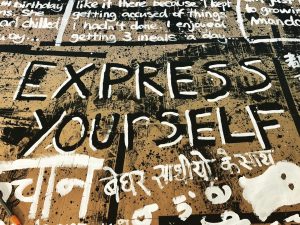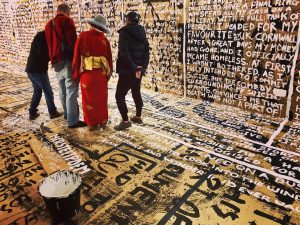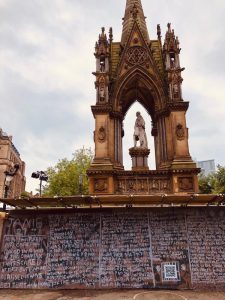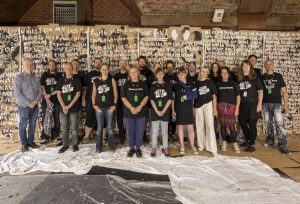
“While its causes are complicated, ending homelessness is simple. We have the know-how and the resources to do so. We lack only three things: imagination, a shared sense of personal responsibility and political will.” – Red Line Service
Two years ago I was part of a team that co-produced Manchester Street Poem (MSP) – a collaboration between those who are, or who have been affected by homelessness; charities across the city addressing homelessness and inequality; Manchester International Festival and the band Underworld. A year’s work together culminated in an artwork (a performed installation and soundscape) sharing the stories of marginalised communities in a disused shoe shop – rebranded UNFEAR – on the outskirts of the city.
Over 10 days we created a different type of gallery space; a space that strived to be equitable, accessible and inclusive. A space in which you were surrounded by stories of struggle, trauma, difficulty, warmth, humour, hope and resilience… emotionally charged but uplifting in tone. Those that came through the doors recognised something of the human condition in all our stories.
Many of the traditional decision makers and people in positions of power in the city came to MSP and for a fleeting moment in July 2017 it became a space for important conversations around social policy to exist in. Taking place against the backdrop of devolution and citywide change, and in the wake of the Manchester bomb, Grenfell and a newly elected Conservative government it felt more important than ever to connect, draw people close and demonstrate that there is more that unites than divides us.

This desire to effect a change in the cultural mind set of my city around homelessness; helping to dispel prejudice and promote a community of ‘us’ with no ‘them’ was the driving force behind my Development Grant activity. I began exploring artists / collectives / organisations nationally and internationally with a similar ambition e.g. Museum of Homelessness (Objectified); More Art (Residents of New York); Claire Patey’s A Mile in My Shoes. One particular project that struck a chord with me was House by Red Line Service in Chicago. This partnership with the Weinberg/Newton Gallery saw them spend the majority of the exhibition budget on providing housing for two local people experiencing homelessness for a year. In the gallery simply hung a set of keys. It reminded me of a conversation I had with Luke [Emery, Bristol-based CPI participant] about a project Bank Job, in which two artists printed their own banknotes/artwork and sold £40,000 worth of them, using the proceeds to fund local projects and buying up and abolishing £1.2m of local high interest debt. How could we start thinking about a project where, as Luke put it “the line is so tremendously blurred that the first thing you see isn’t art or activism”. What if we simply gave our Development Grant money away? I looked more into the House model and how they used the gallery and visitors to it to engage in a conversation about socially engaged art, homelessness and take collective action.
Public encounters that transform conversation into collective action intrigued me. Too often discussions take the format of a conference or symposium; I wanted to explore spaces where there was shared risk and responsibility, talk AND action – spaces occupied by Legislative Theatre (Theatre of the Oppressed NYC / Cardboard Citizens (Rising and Citizens Do); Congress (All the Queen’s Men); and the Laundromat Project. I had the opportunity to reflect on this first hand as part of Heart of Glass’ ‘anti-conference’ Making a Meal of It which looked at participating in the arts through the collective action of creating, serving and eating a meal together, documenting the process and publishing our findings within the timeframe of the gathering. Not only did it make me feel differently about participants after participating in something about participation (!) but a significant part of the day was spent interrogating how we make decisions – is it truly democratic – and how we should spend the £555 we (and each of the groups) had been given to create our course. We spoke about ethics, responsibility, power and control, all subjects hot on the agenda of the first Co-Creating Change Network meeting, which asked “In the process of co-creation, how do we give up control while ensuring high artistic quality? And are our notions of quality valid?” It seemed that the fear was by handing over control, things were out of control. A further session on redistributing power firstly prompted questions around who are we to give ourselves power to redistribute but also led to a comment that stuck with me “make sure ‘their’ words aren’t coming out of ‘our’ mouths”.
Although this phrase felt a little ‘other’ and not quite in keeping with the ‘no them and us’ approach in relation to MSP, we knew that we could push the co-creation of the artwork even further. While individuals shared their stories, it was Karl [Hyde] that painted them. After MIF17, we began running monthly storytelling workshops, which sought to widen our MSP community and foster deeper and greater investment and ownership over what they wanted to say. Come the International Arts & Homelessness Festival in Manchester in November 2018 a strengthened team was ready to take over 57 Spring Gardens – an office space in the city centre – construct the making space together and over the course of the week paint their own stories on the wall. Over 200 people visited the residency with Festival delegates and members of the public also invited make their mark. Interactivity was the key and universally we all felt, although smaller in scale it was bigger in ideas.
I knew investing part of my Development Grant in the next iteration of MSP during MIF19 would resonate with so much of the things that preoccupied my mind during our first CPI residency in Bristol – reimagining a city’s forgotten spaces, reigniting the inner community activist, creating a platform for possibility and a space to have conversations with kindness, humility and empathy. For all of us, working in the public realm became important – taking stories onto the streets and starting a conversation with those that didn’t (or wouldn’t) step foot in UNFEAR or Spring Gardens. Aesthetically we wanted to keep it the same – using cardboard to represent how art – and art materials – can be free and accessible. We looked at partnering with artists such as Liam Hopkins and the huge cardboard structures he makes through his studio Lazerian but kept coming back to the idea of a changing landscape, of new stories appearing each day.
We secured a workshop space within a disused railway arch in the city centre, which became a making space. Here, two huge cardboard canvases (each measuring 11.5m x 2.5m) were constructed and over 13 days (8-21 July) we worked collaboratively to share 21 stories and create 13 new artworks. Each evening, the artwork created that day was photographed, printed at scale and fly-posted onto a specially constructed billboard in Albert Square, the city’s main public square directly outside the Town Hall. Rebranded as Festival Square for the 18 days of the Festival – and attracting a diverse mix of non-arts audiences – it saw audiences of 165,000 at MIF19. Although our intention was always for the widest possible audience to engage with MSP at Festival Square, just under 400 members of the public came to see the work being created – including guests such as Danny Boyle, Laurie Anderson, Mary Anne Hobbs and Brian Eno – and two major news pieces were recorded in the space for Granada Reports and BBC NW Tonight.

The role of play in times of crisis or when tackling a subject such as homelessness is something that has always interested me and I’m a firm believer in its ability to build social bonds. One of the most playful moments of this project was each morning when together we unleashed our creativity with the black paint –hands, feet, mops and brushes splashing against the fresh cardboard canvas. It’s messy, carefree, liberating and in that moment we’re family. Audiences who came to see us in the workshop seemed at first to seek permission to ‘play’ – “can we really paint on the artwork?” – but lit up on realising we actively sought their interaction. One of the most joyful moments for me was on the last day stepping back to watch as visitors to the space wrote their own feelings about the project alongside the MSP team before it broke into an impromptu karaoke session – truly a moment of ‘us, with no them’.
This activity was about starting a conversation and a huge positive was our contributors being on Festival Square alongside the work, interacting with members of the public. “They say a problem shared is a problem halved, well I’ve shared my story with so many people it’s nearly all gone now.” “Every day there’ll be a different story up on that wall and it will tell you a different side of Manchester. As soon as I got onto Festival Square it was like, come on, let’s talk”. “For me, painting that story up on the wall is better than therapy. I want the world to change and I can’t do that on my own so Street Poem is giving me that voice.” People from all walks of life interacted with the work: people working across the voluntary, health, housing, education sector, while probation officers, councillors and care providers asked to purchase pieces of the artwork to prompt further conversations.
There were some definite challenges to working in the public realm – when holding the mirror up to society, people aren’t always going to like what they see and are resistant. Some questioned the platforming of such an issue or raised concerns around showcasing the words of “disreputable” individuals. While our opinions differed, at least we were engaged in discussion. The duty of care to our MSP team is of the highest priority but this time there was the added duty of care we had to Festival audiences and families encountering the work in public space. Whereas with UNFEAR and Spring Gardens we were able to ensure the safeguarding of all who entered the space and fulfil our duty of care in signposting to any onwards support, here in public space we couldn’t mitigate the risks around triggering / safeguarding people and children on site. A compromise had to be reached and so we worked with seven of our 21 storytellers on particularly sensitive content. On these artworks the following message was displayed, “This story has been edited for a family audience. For the full version visit mcrstreetpoem.com or scan the QR code” which actually drove significant traffic to our online content. These are hard-hitting stories and we never want to shy away from or avoid the truth of that.
So what’s next? We’re currently in the process of setting up MSP as a Registered Charity and I believe there is more work to do to see how we can move towards fair payment policy for everyone involved while ensuring it doesn’t negatively impact anyone e.g. benefits are affected and that the project is sustainable.
My involvement with MSP – and the time afforded me through CPI to do this – has definitely given me a greater connection to the city’s ecology. I feel a significant part of the community and conversation that is being had here around homelessness and through the Manchester Homelessness Partnership we have seen the benefit of co-production and cross-sector collaboration. It is brilliant and hugely exciting to now be able to contribute to this conversation nationally – through projects such as Cardboard Citizens’ Cardboard Camp – and internationally. MSP is currently exploring its involvement in the Tokyo 2020 Cultural Olympiad, with some of the team having just returned from With One Voice’s arts and homelessness exchange in Japan, learning about the local context, arts interventions and sharing experiences / practice / toolkits with Cocoroom, ARCH and Sokerissa dance company.

Not only has this work given me the headspace to see my city differently and understand fully the change I want to make, it has forced me to see myself differently and focus and reflect on my own practice. I can be massively process driven, focussed and fixed on one way of working. All the most interesting work I’ve experienced through my research and the delivery of this activity challenges this notion and points to letting go of control and process in order for everyone involved to be drawn deeper in. Being comfortable with being uncomfortable, the ability to challenge in the right way and ask difficult questions are all attributes that will also benefit my role at MIF, particularly over the next few years as we move towards The Factory and co-design activity that celebrates and builds the skills, confidence and creative capacity of my city. I plan to spend the last of my Development Grant on a number of coaching sessions looking at conscious leadership, effective communication and public speaking, but the weapon I will always have in my arsenal is now a network of international Creative Producers – or should I say co-conspirators and collaborators – who challenge and inspire me to make work that “prods and pokes at the bit that makes me feel uneasy”.
